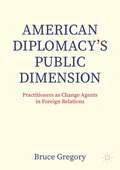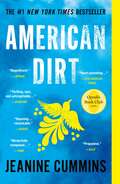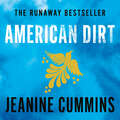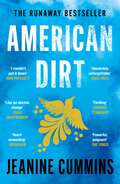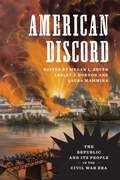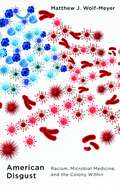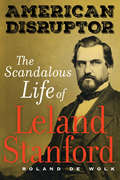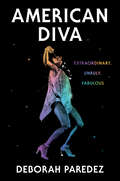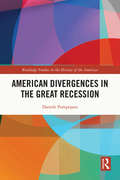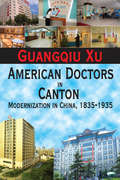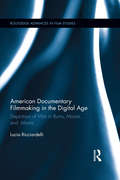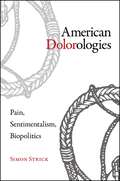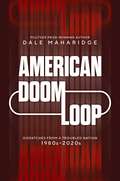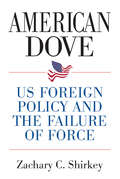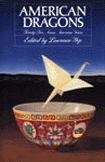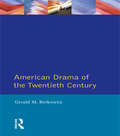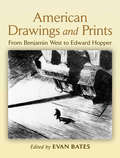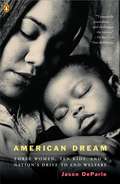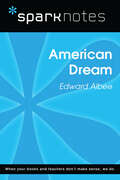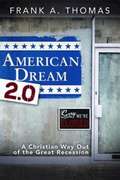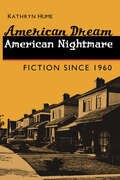- Table View
- List View
American Diplomacy’s Public Dimension: Practitioners as Change Agents in Foreign Relations (Palgrave Macmillan Series in Global Public Diplomacy)
by Bruce GregoryThis is the first book to frame U.S. public diplomacy in the broad sweep of American diplomatic practice from the early colonial period to the present. It tells the story of how change agents in practitioner communities – foreign service officers, cultural diplomats, broadcasters, citizens, soldiers, covert operatives, democratizers, and presidential aides – revolutionized traditional government-to-government diplomacy and moved diplomacy with the public into the mainstream. This deeply researched study bridges practice and multi-disciplinary scholarship. It challenges the common narrative that U.S. public diplomacy is a Cold War creation that was folded into the State Department in 1999 and briefly found new life after 9/11. It documents historical turning points, analyzes evolving patterns of practice, and examines societal drivers of an American way of diplomacy: a preference for hard power over soft power, episodic commitment to public diplomacy correlated with war and ambition, an information-dominant communication style, and American exceptionalism. It is an account of American diplomacy’s public dimension, the people who shaped it, and the socialization and digitalization that today extends diplomacy well beyond the confines of embassies and foreign ministries.
American Dirt: A Novel
by Jeanine Cummins<P><P>También de este lado hay sueños. On this side, too, there are dreams. <P><P>Lydia Quixano Pérez lives in the Mexican city of Acapulco. She runs a bookstore. She has a son, Luca, the love of her life, and a wonderful husband who is a journalist. And while there are cracks beginning to show in Acapulco because of the drug cartels, her life is, by and large, fairly comfortable. <P><P>Even though she knows they’ll never sell, Lydia stocks some of her all-time favorite books in her store. And then one day a man enters the shop to browse and comes up to the register with a few books he would like to buy—two of them her favorites. <P><P>Javier is erudite. He is charming. And, unbeknownst to Lydia, he is the jefe of the newest drug cartel that has gruesomely taken over the city. When Lydia’s husband’s tell-all profile of Javier is published, none of their lives will ever be the same. <P><P>Forced to flee, Lydia and eight-year-old Luca soon find themselves miles and worlds away from their comfortable middle-class existence. Instantly transformed into migrants, Lydia and Luca ride la bestia—trains that make their way north toward the United States, which is the only place Javier’s reach doesn’t extend. As they join the countless people trying to reach el norte, Lydia soon sees that everyone is running from something. But what exactly are they running to? American Dirt will leave readers utterly changed. It is a literary achievement filled with poignancy, drama, and humanity on every page. It is one of the most important books for our times. <p><b>A New York Times Bestseller</b>
American Dirt: THE SUNDAY TIMES AND NEW YORK TIMES BESTSELLER
by Jeanine Cummins'I couldn't put it down. I'll never stop thinking about it' Ann Patchett'One hell of a novel about a good woman on the run with her beautiful boy' Stephen KingFEAR KEEPS THEM RUNNING. HOPE KEEPS THEM ALIVE.Vivid, visceral, utterly compelling, AMERICAN DIRT is the first novel to explore the experience of attempting to illegally cross the US-Mexico border. Described as 'A Grapes of Wrath for our times' (Don Winslow) it is a story that will leave you utterly changed.Yesterday, Lydia had a bookshop.Yesterday, Lydia was married to a journalist.Yesterday, she was with everyone she loved most in the world.Today, her eight-year-old son Luca is all she has left.For him, she will carry a machete strapped to her leg.For him, she will leap onto the roof of a high speed train.For him, she will find the strength to keep running.(P)2020 Macmillan Audio
American Dirt: The heartstopping story that will live with you for ever
by Jeanine Cummins**Jeanine Cummins' new novel Speak to Me of Home is available to pre-order now**'Heartstopping... doesn't let up... you will urge them on, fists clenched' The TimesAn extraordinary story of the lengths a mother will go to to save her son, AMERICAN DIRT has sold over 2 million copies worldwide. It's time to read what you've been missing.Lydia Perez owns a bookshop in Acapulco, Mexico, and is married to a fearless journalist. Luca, their eight-year-old son, completes the picture. But it only takes a bullet to rip them apart.In a city in the grip of a drug cartel, friends become enemies overnight, and Lydia has no choice but to flee with Luca at her side. North for the border... whatever it takes to stay alive. The journey is dangerous - not only for them, but for those they encounter along the way. Who can be trusted? And what sacrifices is Lydia prepared to make?*An Instant New York Times #1 Bestseller 2020**An Instant Sunday Times Top Ten Bestseller 2020**Over 2 million copies sold globally**A Richard and Judy Bookclub Pick**An Oprah's Book Club Pick**A BBC Radio 4 Book at Bedtime*
American Discord: The Republic and Its People in the Civil War Era
by John F. Marszalek Lawrence A. Kreiser Jr. Rob Hart Kevin Hughes T. Michael Parrish Adam Petty Charity Rakestraw Glenn Brasher Daniel Burge Katie Deale Will Greene Lindsey Privette Chris Teeters Christian McWhirterA panoramic collection of essays written by both established and emerging scholars, American Discord examines critical aspects of the Civil War era, including rhetoric and nationalism, politics and violence, gender, race, and religion. Beginning with an overview of the political culture of the 1860s, the collection reveals that most Americans entered the decade opposed to political compromise. Essays from Megan L. Bever, Glenn David Brasher, Lawrence A. Kreiser Jr., and Christian McWhirter discuss the rancorous political climate of the day and the sense of racial superiority woven into the political fabric of the era.Shifting focus to the actual war, Rachel K. Deale, Lindsay Rae Privette, Adam H. Petty, and A. Wilson Greene contribute essays on internal conflict, lack of compromise, and commitment to white supremacy. Here, contributors adopt a broad understanding of “battle,” considering environmental effects and the impact of the war after the battles were over. Essays by Laura Mammina and Charity Rakestraw and Kristopher A. Teters reveal that while the war blurred the boundaries, it ultimately prompted Americans to grasp for the familiar established hierarchies of gender and race.Examinations of chaos and internal division suggest that the political culture of Reconstruction was every bit as contentious as the war itself. Former Confederates decried the barbarity of their Yankee conquerors, while Republicans portrayed Democrats as backward rubes in need of civilizing. Essays by Kevin L. Hughes, Daniel J. Burge, T. Robert Hart, John F. Marszalek, and T. Michael Parrish highlight Americans’ continued reliance on hyperbolic rhetoric. American Discord embraces a multifaceted view of the Civil War and its aftermath, attempting to capture the complicated human experiences of the men and women caught in the conflict. These essays acknowledge that ordinary people and their experiences matter, and the dynamics among family members, friends, and enemies have far-reaching consequences.
American Disgust: Racism, Microbial Medicine, and the Colony Within
by Matthew J. Wolf-MeyerExamining the racial underpinnings of food, microbial medicine, and disgust in America American Disgust shows how perceptions of disgust and fears of contamination are rooted in the country&’s history of colonialism and racism. Drawing on colonial, corporate, and medical archives, Matthew J. Wolf-Meyer argues that microbial medicine is closely entwined with changing cultural experiences of digestion, excrement, and disgust that are inextricably tied to the creation of whiteness. Ranging from nineteenth-century colonial encounters with Native people to John Harvey Kellogg&’s ideas around civilization and bowel movements to mid-twentieth-century diet and parenting advice books, Wolf-Meyer analyzes how embedded racist histories of digestion and disgust permeate contemporary debates around fecal microbial transplants and other bacteriotherapeutic treatments for gastrointestinal disease. At its core, American Disgust wrestles with how changing cultural notions of digestion—what goes into the body and what comes out of it—create and impose racial categories motivated by feelings of disgust rooted in American settler-colonial racism. It shows how disgust is a changing, yet fundamental, aspect of American subjectivity and that engaging with it—personally, politically, and theoretically—opens up possibilities for conceptualizing health at the individual, societal, and planetary levels.
American Disruptor: The Scandalous Life of Leland Stanford
by Roland De WolkAmerican Disruptor is the untold story of Leland Stanford – from his birth in a backwoods bar to the founding of the world-class university that became and remains the nucleus of Silicon Valley. The life of this robber baron, politician, and historic influencer is the astonishing tale of how one supremely ambitious man became this country's original "disruptor" – reshaping industry and engineering one of the greatest raids on the public treasury for America’s transcontinental railroad, all while living more opulently than maharajas, kings, and emperors. It is also the saga of how Stanford, once a serial failure, overcame all obstacles to become one of America’s most powerful and wealthiest men, using his high elective office to enrich himself before losing the one thing that mattered most to him – his only child and son. Scandal and intrigue would follow Stanford through his life, and even after his death, when his widow was murdered in a Honolulu hotel – a crime quickly covered up by the almost stillborn university she had saved. Richly detailed and deeply researched, American Disruptor restores Leland Stanford’s rightful place as a revolutionary force and architect of modern America.
American Diva: Extraordinary, Unruly, Fabulous
by Deborah ParedezAn impassioned homage to the divas who shake up our world and transform it with their bold, dazzling artistry. What does it mean to be a “diva”? A shifting, increasingly loaded term, it has been used to both deride and celebrate charismatic and unapologetically fierce performers like Aretha Franklin, Divine, and the women of Labelle. In this brilliant, powerful blend of incisive criticism and electric memoir, Deborah Paredez—scholar, cultural critic, and lifelong diva devotee—unravels our enduring fascination with these icons and explores how divas have challenged American ideas about feminism, performance, and freedom. American Diva journeys into Tina Turner’s scintillating performances, Celia Cruz’s command of the male-dominated salsa world, the transcendent revival of Jomama Jones after a period of exile, and the unparalleled excellence of Venus and Serena Williams. Recounting how she and her mother endlessly watched Rita Moreno’s powerhouse portrayal of Anita in West Side Story and how she learned much about being bigger than life from her fabulous Tía Lucia, Paredez chronicles the celebrated and skilled performers who not only shaped her life but boldly expressed the aspiration for freedom among brown, Black, and gay communities. Paredez also traces the evolution of the diva through the decades, dismayed at the mid-aughts’ commodification and juvenilizing of its meaning but finding its lasting beauty and power. Filled with sharp insights and great heart, American Diva is a spirited tribute to the power of performance and the joys of fandom.
American Divergences in the Great Recession
by Daniele PompejanoGlobalization is quite different from internationalization: the by-now global market economy overwhelmed the sovereignty of the old national states. Close to the 2007 crisis, some de-coupling effects were consequent in most developed countries in comparison with the ex-Third World. Latin America seemed to entail a "divergence" with the First World, as unlike the past, it was not hit by the financial crisis, but old historical fragilities invalidated the short positive cycle produced by high international prices. This work deals with this crisis and its basic differences from the older crises of the Thirties and Seventies.
American Doctors in Canton: Modernization in China, 1835-1935
by Guangqiu XuTraditional Chinese medicine developed over thousands of years, but changes introduced from 1835-1935 by American missionary doctors initiated a landslide of cultural revolution in the city of Canton and medical modernization throughout China. Focusing on medical missionaries' ideas and approaches in a principal city of the period, Canton, Guangqiu Xu, a native of Canton, describes the long-term impact of American models of medical work, which are still in place in China today. Despite stiff resistance to change and Chinese suspicion of foreign ideas, the impact of American medical missionaries was profound. They opened medical schools, trained modern doctors, and promoted public health education. These transformations in turn led to major social movements in the modernization of Canton, such as the women's rights movement, modern charity and welfare systems, and modern hygiene campaigns. This book focuses on the changes American doctors brought to Canton, their implementation, what remains of their influence today, and how some of these transformations have spread across China. It shows that the Chinese have themselves become more responsive to cultural relations with the US as part of the acceptance of these changes, and demonstrates how the unique blend of modern Western and traditional Chinese medicines has helped modernize China and make Canton the cradle of modern reform and revolution in China.
American Documentary Filmmaking in the Digital Age: Depictions of War in Burns, Moore, and Morris (Routledge Advances in Film Studies)
by Lucia RicciardelliAmerican Documentary Filmmaking in the Digital Age examines the recent challenges to the conventions of realist documentary through the lens of war documentary films by Ken Burns, Michael Moore, and Errol Morris. During the twentieth century, the invention of new technologies of audiovisual representation such as cinema, television, video, and digital media have transformed the modes of historical narration and with it forced historians to assess the impact of new visual technologies on the construction of history. This book investigates the manner in which this contemporary Western "crisis" in historical narrative is produced by a larger epistemological shift in visual culture. Ricciardelli uses the theme of war as depicted in these directors’ films to focus her study and look at the model(s) of national identity that Burns, Morris, and Moore shape through their depictions of US military actions. She examines how postcolonial critiques of historicism and the advent of digitization have affected the narrative structure of documentary film and the shaping of historical consciousness through cinematic representation.
American Dolorologies: Pain, Sentimentalism, Biopolitics (SUNY Press Open Access)
by Simon StrickAmerican Dolorologies presents a theoretically sophisticated intervention into contemporary equations of subjectivity with trauma. Simon Strick argues against a universalism of pain and instead foregrounds the intimate relations of bodily affect with racial and gender politics. In concise and original readings of medical debates, abolitionist photography, Enlightenment philosophy, and contemporary representations of torture, Strick shows the crucial function that evocations of "bodies in pain" serve in the politicization of differences. This book provides a historical contextualization of contemporary ideas of suffering, sympathy, and compassion, thus establishing an embodied genealogy of the pain that is at the heart of American democratic sentiment.This book is freely available in an open access edition thanks to Knowledge Unlatched—an initiative that provides libraries and institutions with a centralized platform to support OA collections and from leading publishing houses and OA initiatives. Learn more at the Knowledge Unlatched website at: https://www.knowledgeunlatched.org/, and access the book online at the SUNY Open Access Repository at http://hdl.handle.net/20.500.12648/1705.
American Doom Loop: Dispatches from a Troubled Nation, 1980s–2020s
by Dale MaharidgeMuch of the contemporary crazy can be traced to the 1980s—America of the 2020s is living with the cultural shapeshifting rooted in that decade.Americans lived in a different reality in 1980: Vermont was the only state that let residents carry a concealed firearm without a permit. Twenty-four states now allow this—and numerous other gun laws have fallen by the wayside. When police were accused of wrongdoing, the default answer from society&’s arbiters—courts, politicians, newspaper editors—was: &“The police wouldn&’t lie.&” Editors steered clear of stories about rape and sexual violence. The word &“homeless&” wasn&’t in common use. The fabric of the middle class had not yet begun fraying. America of the 2020s is living with cultural shapeshifting rooted in the 1980s. History, of course, is not a snapshot—it&’s a film. To understand the United States today, we have to know the 1980s. American Doom Loop chronicles the first part of that moving picture, then brings the story forward. As a newspaper journalist, Dale Maharidge had a front-row seat to this decade, immersed in disparate worlds. He was in the Philippines during the last days of Dictator Ferdinand Marcos, witnessing the US lose a critical piece of its empire dating to the Spanish–American War; he traveled to Central America where the East-West conflict was playing out by proxy; he smuggled a Salvadoran family marked by death squads, driving them through trackless desert to the US border; he embedded with a group that was a precursor to the Oath Keepers; and he investigated police, who kept trying to get him fired. Through it all, Maharidge gained an invaluable view of a complicated decade that offers insight into our society today.
American Dove: US Foreign Policy and the Failure of Force
by Zachary ShirkeyZachary C. Shirkey argues that the United States is overly reliant on the active use of force and should employ more peaceful foreign policy tools. Force often fails to achieve its desired ends for both tactical and strategic reasons and is relatively infungible, making it an inappropriate tool for many US foreign policy goals. Rather than relying on loose analogies or common sense as many books on US grand strategy do, American Dove bases its argument directly on an eclectic mix of academic literature, including realist, liberal, and constructivist theory as well as psychology. Shirkey also argues against retrenchment strategies, such as offshore balancing and strategic restraint as lacking a moral component that leaves them vulnerable to hawkish policies that employ moral arguments in favor of action. US withdrawal would weaken the existing liberal international security, economic, and legal orders—orders that benefit the United States. Rather, the book argues the United States needs an energetic foreign policy that employs passive uses of force such as deterrence and nonmilitary tools such as economic statecraft, international institutions, international law, and soft power. Such a policy leaves room for a moral component, which is necessary for mobilizing the American public and would uphold the existing international order. Last, Shirkey argues that to be successful, doves must frame their arguments in terms of strategy rather than in terms of costs and must show that dovish policies are consistent with national honor and a broad range of American values. American Dove offers a framework for US grand strategy and a plan for persuading the public to adopt it.
American Dragons: Twenty-Five Asian American Voices
by Laurence YepA collection of writings by 25 Asian-Americans.
American Drama of the Twentieth Century (Longman Literature In English Series)
by Gerald M. BerkowitzIn this book Professor Berkowitz studies the diversity of American drama from the stylistic, experimental plays of O'Neill, through verse, tragedy and community theatre, to the theatre of the 1990s. The discussions range through dramatists, plays, genres and themes, with full supporting appendix material. It also examines major dramatists such as Eugene O'Neill, Arthur Miller, Sam Shephard, Tennessee Williams and August Wilson and covers not only the Broadway scene but also off Broadway movements and fringe theatres and such subjects as women's and African-American drama.
American Drawings and Prints: From Benjamin West to Edward Hopper
by Evan BatesThis handsome retrospective offers an affordable treasury of nearly 100 works by the nation's best and most popular artists. Ranging from the colonial era to the early twentieth century, it features drawings by anonymous folk artists as well as such famous figures as James Abbott McNeill Whistler, Winslow Homer, Mary Cassatt, Stuart Davis, Rockwell Kent, and Yasuo Kuniyoshi.Skyscrapers, smokestacks, traffic, and other city scenes begin the collection, in a sequence of images that capture the vitality of urban life, including John Marin's Woolworth Building and Brooklyn Bridge, Joseph Stella's Pittsburgh Winter, and Adolf Dehn's Art Lovers and Artistes' Café. Lithographs of landscapes and country vignettes feature the works of Grant Wood, Thomas Hart Benton, John Steuart Curry, and other noted Regionalists. A series of portraits includes a chalk drawing by John Singleton Copley of a nobleman as well as a study by Thomas Eakins for his masterpiece, The Gross Clinic. The anthology concludes with an appealing selection of folk and fantasy art, inspired by scenes from mythology, Shakespeare, and the Bible.
American Dream
by William J. Poorvu Richard E. Crum Donald A. BrownExplores the process of purchasing a single family house through the eyes of a young couple. The couple is trying to determine what type of home to buy as well as how to finance it.
American Dream
by Jason DeparleIn this definitive work, two-time Pulitzer finalist Jason DeParle cuts between the mean streets of Milwaukee and the corridors of Washington to produce a masterpiece of literary journalism. At the heart of the story are three cousins whose different lives follow similar trajectories. Leaving welfare, Angie puts her heart in her work. Jewell bets on an imprisoned man. Opal guards a tragic secret that threatens her kids and her life. DeParle traces their family history back six generations to slavery and weaves poor people, politicians, reformers, and rogues into a spellbinding epic. With a vivid sense of humanity, DeParle demonstrates that although we live in a country where anyone can make it, generation after generation some families don't. To read American Dream is to understand why.
American Dream (SparkNotes Literature Guide Series)
by SparkNotesAmerican Dream (SparkNotes Literature Guide) by Edward Albee Making the reading experience fun! Created by Harvard students for students everywhere, SparkNotes is a new breed of study guide: smarter, better, faster.Geared to what today's students need to know, SparkNotes provides:*chapter-by-chapter analysis *explanations of key themes, motifs, and symbols *a review quiz and essay topics Lively and accessible, these guides are perfect for late-night studying and writing papers.
American Dream 2.0: A Christian Way Out of the Great Recession
by Frank A. ThomasThe promise of America has always been creative potential: enterprise, industry, optimism, idealism, and hope. This promise, known since the beginning of the New World and named since the Great Depression as the "American Dream", is what makes immigrants cry at the base of the Statue of Liberty. But there is a dark side to the American Dream, too—one that we don’t talk about much in polite company. A side characterized by the exploitation and domination of subjected people.The national climate has caused many to question the validity of the American Dream, and whether it even offers a viable vision for the nation. There are few greater questions to ask. Our collective future depends on a common vision. If the American Dream is dead, then what happens next?This book evaluates the American Dream, establishes its roots, gives reasons for its decline, and offers solutions to reclaim the promise of the American Dream that is more aligned with Jesus’ vision of the kingdom of God and Martin Luther King Jr’ s vision of the "Beloved Community". Our challenge is to develop a redesigned American Dream, a sustainable future for all, free from exploitation and domination of subjected people.
American Dream Machine
by Matthew SpecktorBeau Rosenwald - overweight, far from handsome, and improbably charismatic - arrives in Los Angles in 1962 with nothing but an ill-fitting suit and a pair of expensive brogues. By the late 1970s he has helped found the most successful agency in Hollywood. Through the eyes of his son, we watch Beau and his partner go to war, waging a battle that will reshape an entire industry. We watch Beau rise and fall and rise again, forging and damaging remarkable relationships. We watch Beau's partner, the enigmatic Williams Farquarsen, struggle to control himself and this oh-so-fickle world of movies. We watch two generations of men fumble and thrive across the LA landscape, revelling in their successes and learning the costs of their mistakes.
American Dream Machine
by Matthew SpecktorBeau Rosenwald - overweight, far from handsome, and improbably charismatic - arrives in Los Angles in 1962 with nothing but an ill-fitting suit and a pair of expensive brogues. By the late 1970s he has helped found the most successful agency in Hollywood. Through the eyes of his son, we watch Beau and his partner go to war, waging a battle that will reshape an entire industry. We watch Beau rise and fall and rise again, forging and damaging remarkable relationships. We watch Beau's partner, the enigmatic Williams Farquarsen, struggle to control himself and this oh-so-fickle world of movies. We watch two generations of men fumble and thrive across the LA landscape, revelling in their successes and learning the costs of their mistakes.
American Dream Machine
by Matthew SpecktorThe story of two talent agents and their three troubled boys, heirs to Hollywood royalty; a sweeping narrative about fathers and sons, the movie business, and the sundry sea changes that have shaped Hollywood and, by extension, American life. American Dream Machine is the story of an iconic striver, a classic self-made man in the vein of Jay Gatsby or Augie March. It's the story of a talent agent and his troubled sons, two generations of Hollywood royalty. It's a sweeping narrative about parents and children, the movie business, and the sundry sea changes that have shaped Hollywood, and by extension, American life. Beau Rosenwald—overweight, not particularly handsome, and improbably charismatic—arrives in Los Angeles in 1962 with nothing but an ill-fitting suit and a pair of expensive brogues. By the late 1970s he has helped found the most successful agency in Hollywood. Through the eyes of his son, we watch Beau and his partner go to war, waging a seismic battle that redraws the lines of an entire industry. We watch Beau rise and fall and rise again, in accordance with the cultural transformations that dictate the fickle world of movies. We watch Beau's partner, the enigmatic and cerebral Williams Farquarsen, struggle to contain himself, to control his impulses and consolidate his power. And we watch two generations of men fumble and thrive across the LA landscape, learning for themselves the shadows and costs exacted by success and failure. Mammalian, funny, and filled with characters both vital and profound, American Dream Machine is a piercing interrogation of the role—nourishing, as well as destructive—that illusion plays in all our lives.
American Dream, American Nightmare: Fiction since 1960
by Kathryn HumeIn this celebration of contemporary American fiction, Kathryn Hume explores how estrangement from America has shaped the fiction of a literary generation, which she calls the Generation of the Lost Dream. In breaking down the divisions among standard categories of race, religion, ethnicity, and gender, Hume identifies shared core concerns, values, and techniques among seemingly disparate and unconnected writers including T. Coraghessan Boyle, Ralph Ellison, Russell Banks, Gloria Naylor, Tim O'Brien, Maxine Hong Kingston, Walker Percy, N. Scott Momaday, John Updike, Toni Morrison, William Kennedy, Julia Alvarez, Thomas Pynchon, Leslie Marmon Silko, and Don DeLillo. Hume explores fictional treatments of the slippage in the immigrant experience between America's promise and its reality. She exposes the political link between contemporary stories of lost innocence and liberalism's inadequacies. She also invites us to look at the literary challenge to scientific materialism in various searches for a spiritual dimension in life. The expansive future promised by the American Dream has been replaced, Hume finds, by a sense of tarnished morality and a melancholy loss of faith in America's exceptionalism. American Dream, American Nightmare examines the differing critiques of America embedded in nearly a hundred novels and points to the source for recovery that appeals to many of the authors.
